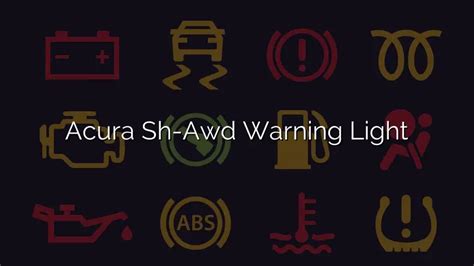Your Acura SH-AWD Light: Causes & Solutions
The Acura Super Handling All-Wheel Drive (SH-AWD) system is a sophisticated piece of engineering, offering superior handling and control. However, when that telltale SH-AWD light illuminates on your dashboard, it can be cause for concern. This comprehensive guide will explore the common causes of an Acura SH-AWD light and provide potential solutions, helping you understand the issue and take appropriate action. Remember, this information is for general guidance; always consult your Acura owner's manual and a qualified mechanic for diagnosis and repair.
What Does the SH-AWD Light Mean?
The SH-AWD warning light indicates a malfunction within the all-wheel-drive system. This doesn't necessarily mean your vehicle is undriveable, but it signifies a problem that requires attention. Ignoring the light could lead to reduced performance, compromised handling, and potentially more significant damage to the system. The exact nature of the problem varies, and that's why proper diagnosis is crucial.
Common Causes of an Acura SH-AWD Light
Several factors can trigger the SH-AWD warning light. Let's delve into the most frequent culprits:
1. Low Fluid Levels
Insufficient fluid in the SH-AWD system is a common cause. The system relies on hydraulic fluid for operation. Low levels can lead to insufficient pressure and trigger the warning light. Checking and topping off the fluid (if possible) is the first troubleshooting step. Consult your owner's manual for the correct type and procedure.
2. Faulty Sensors
The SH-AWD system relies on various sensors to monitor its operation. A malfunctioning sensor, such as a wheel speed sensor, yaw rate sensor, or a steering angle sensor, can send incorrect information to the system's control unit, triggering the warning light. These sensors need professional diagnosis and replacement if faulty.
3. Electrical Problems
Issues within the SH-AWD system's wiring harness, connectors, or the control unit itself can lead to the warning light. This could range from a simple loose connection to more serious electrical damage. A qualified technician needs to diagnose and repair electrical problems.
4. Malfunctioning Components
More serious issues might involve problems with the SH-AWD system's components, such as the pump, clutch packs, or actuators. These are more complex repairs requiring specialized tools and knowledge, best left to a professional mechanic.
5. Wheel Speed Sensor Issues
What are the symptoms of a faulty wheel speed sensor in relation to the SH-AWD light? A faulty wheel speed sensor can cause inaccurate speed readings, leading to the SH-AWD light illuminating. You might also notice ABS or traction control system warnings, and potentially uneven braking or handling.
6. Is it safe to drive with the SH-AWD light on?
Is it safe to drive with the SH-AWD light on? While you might be able to drive with the light on, it's generally not recommended. Driving with a malfunctioning SH-AWD system can impact handling, traction, and overall vehicle safety, particularly in adverse weather conditions. It's best to have the issue diagnosed and repaired as soon as possible.
7. How much does it cost to fix an SH-AWD problem?
How much does it cost to fix an SH-AWD problem? Repair costs vary significantly depending on the cause. A simple fluid top-up is inexpensive, while a faulty component or electrical issue could involve substantial repair bills. Get a proper diagnosis from a mechanic to understand the cost before proceeding with repairs.
Troubleshooting Steps
Before rushing to the mechanic, try these basic troubleshooting steps:
- Check the fluid level: Consult your owner's manual for the correct fluid type and procedure.
- Inspect the wiring harness: Look for any visible damage or loose connections.
- Have the vehicle scanned: A professional diagnostic scan can pinpoint the exact problem.
When to Seek Professional Help
If the SH-AWD light remains on after attempting basic troubleshooting, or if you notice any unusual handling or performance issues, it’s crucial to seek professional help immediately. Ignoring the problem could lead to more extensive and costly repairs.
This article provides general information and should not be considered a substitute for professional advice. Always consult your Acura owner’s manual and a qualified mechanic for accurate diagnosis and repair. Remember that the safety and performance of your vehicle are paramount.

